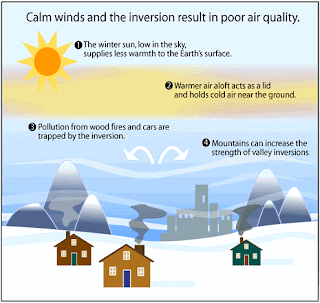What are temperature inversions?
On most days, the temperature of air in the atmosphere is cooler the higher up in altitude you go. This is because most of the suns energy is converted to sensible heat at the ground, which in turn warms the air at the surface. The warm air rises in the atmosphere, where it expands and cools. Sometimes, however, the temperature of air actually increases with height. The situation of having warm air on top of cooler air is referred to as a temperature inversion, because the temperature profile of the atmosphere is "inverted" from its usual state. There are two types of temperature inversions: surface inversions that occur near the Earth's surface, and aloft inversions that occur above the ground. Surface inversions are the most important in the study of air quality.
How do surface temperature inversions form? The most common manner in which surface inversions form is through the cooling of the air near the ground at night. Once the sun goes down, the ground loses heat very quickly, and this cools the air that is in contact with the ground. However, since air is a very poor conductor of heat, the air just above the surface remains warm. Conditions that favor the development of a strong surface inversion are calm winds, clear skies, and long nights. Calm winds prevent warmer air above the surface from mixing down to the ground, and clear skies increase the rate of cooling at the Earth's surface. Long nights allow for the cooling of the ground to continue over a longer period of time, resulting in a greater temperature decrease at the surface. Since the nights in the wintertime are much longer than nights during the summertime, surface inversions are stronger and more common during the winter months. A strong inversion implies a substantial temperature difference exists between the cool surface air and the warmer air aloft. During the daylight hours, surface inversions normally weaken and disappear as the sun warms the Earth's surface. However, under certain meteorological conditions, such as strong high pressure over the area, these inversions can persist as long as several days. In addition, local topographical features can enhance the formation of inversions, especially in valley locations.
How do inversions impact air quality? Surface temperature inversions play a major role in air quality, especially during the winter when these inversions are the strongest. The warm air above cooler air acts like a lid, suppressing vertical mixing and trapping the cooler air at the surface. As pollutants from vehicles, fireplaces, and industry are emitted into the air, the inversion traps these pollutants near the ground, leading to poor air quality. The strength and duration of the inversion will control AQI levels near the ground. A strong inversion will confine pollutants to a shallow vertical layer, leading to high AQI levels, while a weak inversion will lead to lower AQI levels. A large contributor to poor air quality during the winter is residential wood burning. Wood smoke contains much higher amounts of particulate pollution than smoke from oil- or gas-fired furnaces. In some areas of the country, local governments issue burn bans to curtail the use of woodstoves and fireplaces under certain weather and pollution conditions during the winter.

wow great job! keep it up.
ReplyDelete